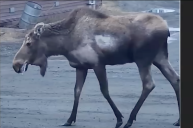It started with the discovery: several dead animals, mostly foxes, in Saguaro National Park near Tucson, Arizona.
Then, creatures in the vicinity—raccoons, foxes, and a bobcat—started acting strangely, exhibiting erratic behavior and showing signs of aggression, according to a news release. Next, a 66-year-old park visitor was attacked by a crazed bobcat on the park's east side, causing injuries severe enough to send the man to the hospital.
Because the bobcat evaded capture and is still at large, officials can't confirm their suspicion that it could be infected with rabies. Park officials said there is reason to believe the unexplained animal deaths and bizarre behavior could be traced to an outbreak of the virus within the park's fur-bearing populations.
The abnormal behavior and fox deaths were first documented in the park at the end of December, according to Beth Hudick, the park's interpretation, education and outreach manager. Since then, there have been additional reports of dead foxes in the park in the last couple of weeks, along with the bobcat bite that occurred on Jan. 21.
So far, park officials have not been able to test any animals, so the rabies theory is not yet confirmed. The park has had periodic cases of suspected rabies in wildlife in the past, though it's been very rare that these suspected cases could be confirmed with testing, Hudick told Wide Open Spaces.

Getty, Nate Hovee
As officials seek answers to whatever is making wildlife in the park sick, erratic, and dangerous, they advise visitors to take extra precautions while on-site. Specifically, people are urged to:
- Steer clear of any wildlife and do not touch any animal. Some animals can be infected and show no symptoms.
- Report sightings of or interactions with sick animals to park rangers.
- Keep pets leashed and make sure they are current on vaccinations.
- Block off any small openings in cabins or tents to ensure that no animals can sneak inside.
- Teach children the signs of rabies and advise them to stay away from wild animals.
- If attacked or bitten by an animal in the park, seek immediate medical attention.
Rabies is a deadly virus, and symptoms can be nonspecific. In animals, it can manifest as hostile behavior, erratic behavior, sluggishness, restlessness, drooling, and more. Some animals don't show signs but can still be infected with the virus. It takes time—weeks or months—after a rabies exposure for symptoms to show. That time is called the incubation period.
"The visitor experience at Saguaro National Park really won't be measurably different," Hudick said. "As always, the best way to have a safe park experience is to maintain a healthy and respectful distance from all wildlife. During this period, we are asking visitors to be extra vigilant and report any abnormal animal behavior to park staff. And as always, please do not approach or handle any wildlife, and always keeps your pets on leash."
Saguaro National Park was declared a national monument on March 1, 1933, by Herbert Hoover. It was elevated to national park status in 1994. The park is separated into eastern and western sections around the city of Tucson.
The suspected rabies outbreak activity is occurring in the eastern section of the park, which is about 20 miles southeast of downtown Tucson.
READ MORE: Officials Document First Case of Rabies in an Alaskan Moose




